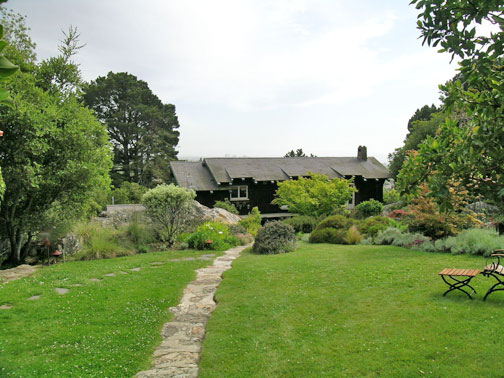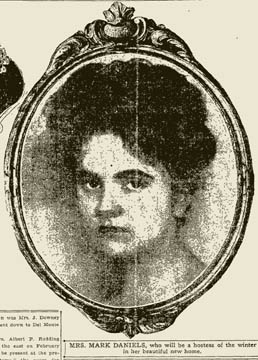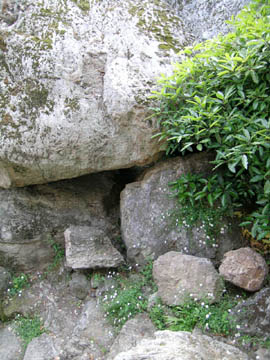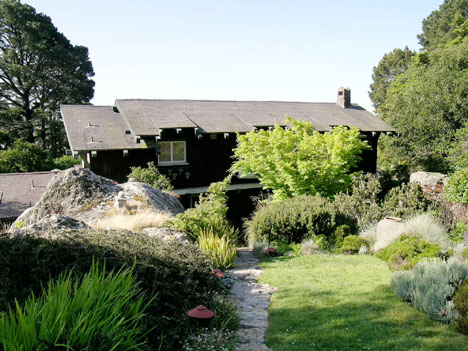Mark Daniels excelled in developing and
marketing scenic beauty18 April 2007
The Mark Daniels house, 1864 Yosemite Road (photo: Daniella Thompson, 2007)Nobody recognized the commercial value of natural scenery better than Mark Daniels. “Developing and selling landscape beauty is perhaps the only way in which a man of the community may have the cake and eat it, too,” he said in June 1914, addressing the Tourist Association of Central California at the Shattuck Hotel in Berkeley. “[T]he visitor does not take one jot from the landscape or the community [...] in return for the money he contributes, nor does the natural beauty of a district or country need to be repaired or replanted each year. And yet the community may sell it and resell it without losing any part of the original bulk of the commodity.”
Two years earlier, in a booklet titled Hillside Homes and Gardens, Daniels extolled the advantages of hill dwelling:
The great history-making nations of the world have invariably been mountain or hill folk, dwelling near the sea. [...] If we wish to develop within ourselves the capacity for inspiration, ambition and a sense of the bigness of things, there is no better way than to seek an environment of inspiring view, where may be seen a portion of the world of sufficient magnitude to give us better perspective and a better sense of the relative importance of things.
But Daniels did much more than speak on the subject. Civil engineer, planner, landscape engineer, national park superintendent, and eventually architect, Daniels (1881–1952) was perhaps the most accomplished practitioner in California of the art of developing and marketing scenic beauty.
Mark Daniels, 1914 (Oakland Tribune)
Frances Daniels, 1911 (Oakland Tribune)Born in Spring Arbor, Mich., the young Daniels will have seen his share of natural rock formations before arriving in California. His parents having settled in Fresno, Mark entered U.C. Berkeley and obtained a B.S. degree in civil engineering. He was one of the better known members of the class of 1905, active in the Skull and Keyes and the Theta Nu Epsilon honor societies, manager of his class Blue and Gold, and playing a prominent role in amateur theatricals, a passion for which he would retain for the rest of his life.
At U.C. he met the first of his four wives, Frances “Dolly” Trost (1888–1941). A gifted singer and artist, Dolly was a soloist member of the Treble Clef Society and a contributor to the Blue and Gold, where one of her pen-and-ink wash drawings “attracted great attention, being considered the best in the book,” according to the Oakland Tribune. The newspaper featured her photograph on several occasions, never failing to refer to her beauty. The couple wed in June 1907 and took up residence near Alta Bates hospital before decamping for Nob Hill in San Francisco.
Having begun his career in workaday civil engineering jobs—he had been superintendent of a placer mine in Plumas County; worked in the engineering department of Southern Pacific; was chief engineer of the Monterey, Fresno & Eastern Railroad; and served as assistant city engineer in Potlach, Idaho before returning to San Francisco to open his own office—Mark had his first chance to develop scenic beauty when John Hopkins Spring subdivided Thousand Oaks in northwest Berkeley.
Blessed with an abundance of water, Coast Live Oaks, and extraordinary rock formations, the area had been a favored locale of the Ohlone, providing both physical and spiritual sustenance. At the turn of the 20th century, it was still a remote and secluded place that attracted hikers, nature lovers, and picnickers, who named the largest of the rocks: Great Stone Face, Tunnel Rock, Monument Rock, Shasta Rock, Picnic Rock.
Parts of Shasta Rock in the Daniels house garden (photos: Daniella Thompson, 2007)
In 1908, while the Chamber of Commerce was waging a quixotic campaign to move the state’s capital to Berkeley, a bond measure proposing to allocate 100 acres in Thousand Oaks for a public park failed at the ballot. The land was soon snapped up by Spring, who had a different vision: an exclusive residential park, with much of its natural beauty privatized.
A streetcar ride along the flower-festooned Arlington Avenue promised “the grandest panorama of the bay ever placed before the eyes of mankind.” (from a postcard, courtesy of Anthony Bruce)The access problem was solved in 1909, when Southern Pacific began planned the Northbrae (Solano) Tunnel that would open in 1911, allowing streetcars to run north on Arlington Avenue. Spring lost no time and hired Matt Roy Thompson of Tacoma to lay out the Thousand Oaks tract.
By 1910, Mark Daniels entered the scene, first laying out the gardens for Spring’s personal 21-acre estate and then mapping Spring’s subsequent subdivisions: Arlington Villa Sites; Thousand Oaks Court; Arlington Heights; Thousand Oaks Station Tract; Arlington Oaks, and blocks 17–19 and 20–24 in Thousand Oaks.
The profusion of rock outcrops made the tract difficult to develop. Daniels entered into partnership with Vance Craigmiles Osmont, a mining engineer associated with U.C. and an expert in volcanic rock. In 1905, Osmont had published the book A Geological Section of the Coast Ranges North of the Bay of San Francisco, in which he described St. Helena rhyolite and proposed the term Bodega diorite for the exposed granitic rocks of the Bodega headland. Both these rocks are related to Northbrae rhyolite, the prevailing rock in Thousand Oaks.
The curvy “Lovers’ Lane” section of Yosemite Road (photo: Daniella Thompson, 2007)
Daniels contoured streets to follow the terrain and curved them around ancient oaks and crags. Lots were sold with their rock outcroppings left intact. Arlington Avenue, the neighborhood’s grand boulevard, was planted in flowers along its full length. The most popular picnic destination, Great Stone Face, was preserved as open space and eventually given to the city for a small public park.
In 1910, Daniels selected a choice—and very rocky—lot for his own house near the Great Stone Face. Although in later years he would join the AIA and design houses (including his own at Pebble Beach and in Bel-Air, Los Angeles), the rustic shingled house he built is the work of Oakland architect A.W. Smith (1864–1933), one of the Bay Area’s most prolific and versatile home designers of the day.
The Daniels house was designed in the Arts & Crafts style by A.W. Smith, with later interior modifications by Walter Ratcliff and Noble Newsom. (photo: Daniella Thompson, 2007)Initially almost square, the Daniels house was modified over the years into a long rectangular structure. Topped with wide roof overhangs, the house is sited parallel to the hillside, obeying Bernard Maybeck’s dictum for the Hillside Club. It is set well away from the street at the bottom of a sloping stone path. Gigantic boulders hem it in on three sides. One of these is the celebrated Shasta Rock.
The Daniels house was built around the same time as the houses of John Spring’s son-in-law, Robert C. Newell, and the latter’s business partner, William C. Murdoch. (Sanborn fire insurance map, 1929)Mark and Frances moved into their new home in early 1911. A year later, one of the front-page stories in the Oakland Tribune recounted how society matron Mrs. Mark Daniels rescued a servant and saved the neighborhood’s reputation by chloroforming to death a skunk found feasting in the garbage can—not exactly what we would characterize as living with nature.
Daniels house, rear
(photos: Daniella Thompson, 2007)
The terraced garden was designed in the 1930s and recently improved with stone walls, stairs, and new plantings. (photo: Daniella Thompson, 2007)Meanwhile, the Thousand Oaks real-estate marketing machine was churning away. In charge of sales were the Newell-Murdoch and George Friend real-estate companies—Robert C. Newell and George Friend had married two of the Springs’ daughters. The former built his house two doors down from Daniels, at 1890 Yosemite Road. Newell-Murdoch Co. had also retained Daniels to lay out the Haddon Hill home park on the east shore of Lake Merritt and Forest Hill in San Francisco. In August 1912, the company’s newspaper ad exclaimed, “Thousand Oaks Heights is in the Path of Progress. It is the only way Berkeley can expand [...] Here the people must come.”
Oakland Tribune, 6 August 1912Citing the federal census, the ad proclaimed Berkeley one of the fastest growing cities in the state and pointed to Thousand Oaks as “the first time in the history of California that suburban and interurban railroads have constructed lines in a district before it was populated.”
With streetcars running every five minutes, residents could reach San Francisco in 40 minutes and the university campus in ten. The fare was five cents.
Explaining why the Key Route, Southern Pacific, and the Oakland Traction Company had invested $4,200,000 in extending car lines into Thousand Oaks ahead of the population, the ad delivered this punch line:
The people are coming—houses are going up—and soon land values will do the same. Invest a few dollars in Thousand Oaks, then sit back and watch it grow. [...] When Thousand Oaks Heights is sold out, there will be no more hill property in the Berkeley district of Alameda County.” Arlington Avenue was dubbed “the street of a million flowers”; a ride on its streetcar line promised “the grandest panorama of the bay ever placed before the eyes of mankind.
Next to the Newell-Murdoch ad, the Homesite Realty Company was touting lots in Arlington Oaks, across the road from Thousand Oaks and a little closer in. “We have retained the services of Mark Daniels, landscape engineer of Daniels and Osmont, to pass upon the landscape merit of every piece of land listed with us. If a lot has not unusual beauty we will not handle it,” trumpeted the ad.
Mark Daniels consented to accompany C.A. McGee and G.H. McCutcheon of the Howard Auto Co., F.G. Lathrop of Southern Pacific, and Oakland Tribune automotive editor Edmund Crinnion on a car trip to Yosemite “in order to get at the heart of the complaints heretofore voiced by autoists on the rules governing the Valley roads.” (Oakland Tribune, 5 July 1914)In April 1914, Daniels was appointed landscape engineer for Yosemite National Park, whose condition was judged unkempt and its beauty marred by inartistic buildings and camps.
Talking to the press, Daniels said, “It is not the object to in any way attempt to add to the beauties of nature within the park, but to develop a plan for the accommodation of utilities so that the government appropriations for each year may cover work to be done in accordance with a carefully worked out and fixed program. The problems in Yosemite Valley are numerous. They comprise sanitation, water supply, lighting, patrolling, fire protection, insect control of concessions and many other things.”
A mere two months after the appointment, Daniels was elevated to the position of superintendent and landscape engineer of national parks, a job in which he lasted only until December 1915. During his tenure, he opened Big Oak Flat Road to Yosemite and sought to increase public accommodations in the parks.
When not on government business, Daniels was laying out Sea Cliff and Crocker-Amazon in San Francisco, executing a development system for a subdivision commissioned by the Spring Valley Water Company, and developing an irrigation system in Butte County.
And then Daniels vanished from Berkeley. His work took him to Monterey and the development of Pebble Beach and the 17-Mile Drive. Several years later, his first marriage in ruins, he would move to Los Angeles, where he would be instrumental in laying out Bel-Air. By the late 1920s, he had expanded his practice to include architecture. Eventually he would return to San Francisco, working on a wide variety of projects, from the Golden Gate International Exposition of 1939–40 to a public housing project in San Francisco’s Chinatown. About 1930, he designed a Berkeley home for his friend and Bohemian Club co-member, the printer John Henry Nash, but Daniels himself would never live here again.
The George C. Davis house in Atherton, designed by Mark Daniels in 1940. (courtesy of the Art Deco Society of California)An army captain in World War I, Mark Daniels was buried in the Golden Gate National Cemetery, San Bruno. Architect Sidney Barker Newsom, who with his brother Noble designed a good number of homes in Thousand Oaks, is also buried there.
This article was published in the Berkeley Daily Planet on 20 April 2007.
Copyright © 2007–2022 Daniella Thompson. All rights reserved.

















